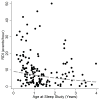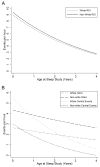Sleep disordered breathing in bronchopulmonary dysplasia
- PMID: 29064170
- PMCID: PMC5693767
- DOI: 10.1002/ppul.23769
Sleep disordered breathing in bronchopulmonary dysplasia
Abstract
Background: There are limited data on the effect of bronchopulmonary dysplasia (BPD) on sleep disordered breathing (SDB). We hypothesized that both the severity of prematurity and BPD would increase the likelihood of SDB in early childhood. Our secondary aim was to evaluate the association of demographic factors on the development of SDB.
Methods: This is a retrospective study of patient factors and overnight polysomnogram (PSG) data of children enrolled in our BPD registry between 2008 and 2015. Association between PSG results and studied variables was assessed using multiple linear regression analysis.
Results: One-hundred-forty children underwent at least one sleep study on room air. The mean respiratory disturbance index (RDI) was elevated at 9.9 events/hr (SD: 10.1). The mean obstructive apnea-hypopnea index (OAHI) was 6.5 (9.1) events/hr and the mean central event rate of 3.0 (3.7) events/hr. RDI had decreased by 22% or 1.5 events/hour (95%CI: 0.6, 1.9) with each year of age (P = 0.005). Subjects with more severe respiratory disease had 38% more central events (P = 0.02). Infants exposed to secondhand smoke had 2.4% lower (P = 0.04) oxygen saturation nadirs and a pattern for more desaturation events. Non-white subjects were found to have 33% higher OAHI (P = 0.05), while white subjects had a 61% higher rate of central events (P < 0.001).
Conclusions: RDI was elevated in a selected BPD population compared to norms for non-preterm children. BPD severity, smoke exposure, and race may augment the severity of SDB. RDI improved with age but was still elevated by age 4, suggesting that this population is at risk for the sequelae of SDB.
Keywords: Sleep Apnea syndromes; polysomnogram; premature infants; sleep.
© 2017 Wiley Periodicals, Inc.
Conflict of interest statement
Figures




References
-
- Ehrenkranz RA, Walsh MC, Vohr BR, Jobe AH, Wright LL, Fanaroff AA, Wrage LA, Poole K National Institutes of Child H, Human Development Neonatal Research N. Validation of the National Institutes of Health consensus definition of bronchopulmonary dysplasia. Pediatrics. 2005;116(6):1353–60. - PubMed
-
- Jobe AH, Bancalari E. Bronchopulmonary dysplasia. Am J Respir Crit Care Med. 2001;163(7):1723–1729. - PubMed
-
- Van Marter LJ. Epidemiology of bronchopulmonary dysplasia. Semin Fetal Neonatal Med. 2009;14(6):358–66. - PubMed
-
- Smith VC, Zupancic JAF, McCormick MC, Croen LA, Greene J, Escobar GJ, Richardson DK. Trends in severe bronchopulmonary dysplasia rates between 1994 and 2002. Journal of Pediatrics. 2005;146(4):469–473. - PubMed
-
- Grisaru-Granovsky S, Reichman B, Lerner-Geva L, Boyko V, Hammerman C, Samueloff A, Schimmel MS, Israel Neonatal N. Population-based trends in mortality and neonatal morbidities among singleton, very preterm, very low birth weight infants over 16 years. Early Hum Dev. 2014;90(12):821–7. - PubMed
MeSH terms
Substances
Grants and funding
LinkOut - more resources
Full Text Sources
Other Literature Sources
Medical

